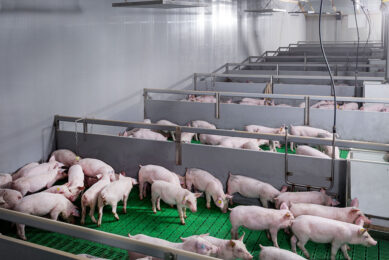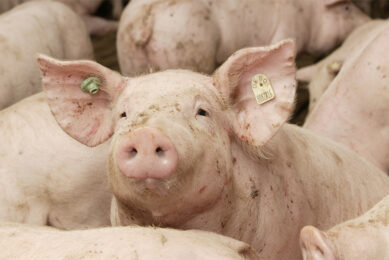Impact of nutrients on gut microbiota

The gut microbial ecosystem is essential for normal nutritional, physiological, and immunological functions of a pig. The nutritional components of a pigs’ diet have a significant effect on microbial alteration along the pig gut which in turn impacts host health and metabolism.
Part of the Gut Health 2022 Special
The microbial population in the gut also known as gut microbiota creates an intricate ecosystem with a symbiotic relationship with the host. Gut microbiota is also referred to as a forgotten organ and it has a profound influence on nutritional, physiological, and immunological functions of the pig, nutrient digestion, disease resistance, production of vitamins and beneficial metabolites, growth performance, feed efficiency, and economic and environmental benefits. Several factors such as low feed intake, and stressors and challenges associated with weaning affect gut structure and function, disrupt the gut microbial ecosystem, compromise gut health, and dramatically increase the risk of diseases.
Gut microbiota and its role
Gut microbiota are microorganisms, including bacteria and other single-celled organisms, that live in the digestive tracts of animals. The microbiota has numerous roles benefiting the host, such as digestion and fermentation of carbohydrates, production of vitamins, maintenance of normal functions of the intestinal villi, regulation of the immune responses, and protection from pathogenic bacteria. Density and diversity of gut microbiota is distinct in different intestinal tracts regions such as in jejunum, ileum, and caecum and in various growing periods from early life to adult. Levels and sources of proteins or fibres shape the diversity and composition of the gut microbiota in pigs.
Nutrient effects on microbial ecology
The nutritional components of the pigs’ diet have a significant effect on microbial alteration along the pig gut which in turn impacts host health and metabolism. In commercial pigs, the need for proteins, fibre, lipids, and carbohydrates differs based on production phase. As the pig grows the dietary protein density decreases in lieu of energy and the feed consumption increases to meet amino acid and energy requirement for maximal growth performance. In gilt developer and gestation diets the fibre is more prominent to provide bulk to the diet. These changes in dietary components affect the microbiota and cause health challenges occurring in the grower periods that follow.
Protein
Proteins, or more specifically, amino acids are required for tissue deposition and bodily function. According to National Research Council (2012) piglets require 22.69% crude proteins and the crude protein requirements increase with size. Although, by the late finishing phase, the crude protein requirement drops to 10.41%. Pre-starter and early nursery diets comprise of a variety of easily digestible protein sources to facilitate gut growth and maturation and to promote nutrient absorption. It is notable that diets containing higher levels of crude protein may cause post-weaning diarrhoea. Reduced crude protein in nursery diets results in reduced growth performance, lower plasma urea and ammonia in the digesta with no effect on the microbiome. Higher dietary crude protein enhances the fluidity and coliform counts of the faeces, reduces Lactobacillus counts, enhances average daily gain, and improves feed conversion efficiency. Fishmeal, soybean meal, and soybean meal/ cottonseed meal diets lead to greater bacterial diversity. In addition, cottonseed meal-based diets augment the abundance of Lactobacillus species and may be beneficial for gut health. Fishmeal enhances the population of Escherichia and Shigella species and promotes the susceptibility to post-weaning diarrhoea.
Lipids
Dietary fat affects gut microbial composition. Diets with polyunsaturated fatty acids supplementation reduce gut endotoxin transport and endotoxemia compared with saturated fat supplementation. Omega-3 polyunsaturated fatty acids supplementation modulates the microbiome to favour beneficial commensal organisms over pathogenic bacteria, decreases the population of Bacteroides species in the cecum of pigs, and improves gut health. In addition, high fat diets result in a greater bacterial population richness, higher total body weight gain, feed efficiency and back fat accumulation than the low-fat diets.
Carbohydrates
Dietary carbohydrates have negative and positive effects when included in pig diets. Wheat starch, and beet pulp increase microbial fermentation, stimulate Lactobacillus species in gut microbiota, and promote a stable and healthy gut microbial ecosystem. Replacing wheat with barley enhances mucosal microbiota uniformity and growth performance. Fibre is essential to maintain normal physiological functions and provides substrate for gut microbes. Fibre-rich diets promote Lactobacillus population and volatile fatty acid formation in the young pigs’ gut. However, insoluble fibre content from a 30% distiller’s dried grains with soluble diet decreases the Firmicutes: Bacteroidetes ratio and Lactobacillus abundance and makes pigs more susceptible to colitis. In nursery and grow-finish pigs, wheat bran fibre increases villus height and villus: crypt depth ratio in the ileum and colon and soybean fibre increases colon volatile fatty acid concentrations. Pea, maize, and wheat bran fibre inclusion increases the population of Lactobacillus and Bifidobacterium but reduces E. coli counts in ileal and colonic digesta. On the other hand, soybean fibre diets decrease the population of Lactobacillus and Bifidobacterium but increase the abundance of E. coli.
Power of the microbiome
Gut microbial ecosystem is essential for normal nutritional, physiological, and immunological functions of the pig. Disturbance in the microbial ecosystem creates an opportunity for pathogenic organisms to colonise and cause disease. Increased understanding of the important role of the microbiome in swine gut health can be applied to manipulate microbiome and to improve pig health and productivity. Although, the process governing the settlement and the maintenance of a balanced intestinal microbiota is not fully understood. Therefore, further research is required to focus on nutritional requirements of the microbiome, microbe-phenotype relationships, precision nutrition under different physiological and metabolic conditions and during poor health to better harness the power of the microbiome to develop new strategies for pork production systems.
Article based on the research paper “The pig microbiota and the potential for harnessing the power of the microbiome to improve growth and health”. Full paper can be accessed through the Journal of Animal Science, Volume 97, Issue 9, September 2019.
 Beheer
Beheer





 WP Admin
WP Admin  Bewerk bericht
Bewerk bericht